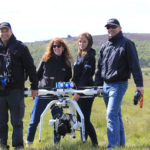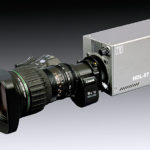
So You Want To Start A Drone Business…
So you want to start a Drone business? Have you the time and the money? ©Blackmagic Design
You’ve unpacked your new drone, you’ve read the manual, it’s charged up, the weather’s great, you’re ready to go right? Well, no, just hang on.
Although it’s very tempting to get out there and fly, there are some important aviation rules that you might not be aware of yet. If you ignore them, you could be prosecuted. Let’s have a look at what they are so we stay safe and stay legal.
In the UK the CAA defines where you can and cannot fly a drone. If it has a camera on board, as most do now, there are specific distance limits you need to know about as well.
The big picture stuff is you’ve got to be able to see your drone at all times. Don’t fly it in a way that could endanger anyone or any property. You are the pilot, so it’s your responsibility to avoid collisions.
To keep out of the way of real aircraft, flown by people, the maximum altitude allowed to fly a drone is 400 feet above ground level (agl). In open areas, aircraft fly as low as 500 feet, so this is an important rule to avoid a potential collision.
As well as keeping away from manned aircraft, you must stay away from any airfields or airports.
If you’ve got a camera on your drone without permission from the CAA, you cannot fly it over or within a congested area. OK great, but what’s classed as a congested area? Well, that’s defined by the CAA as ‘any area of a city, town or settlement which is substantially used for residential, industrial, commercial or recreational purposes’. This means that a quick flight out of your back garden (unless you live on a country estate) is not allowed. Flying down Blackpool promenade? No, not allowed.
Again with camera-equipped drones, there’s a specific limit on how close you can get to people, buildings, vehicles and structures. Basically anything that can damage or be damaged by your drone, you need to keep away from. The limit is 50m, any closer and you could be prosecuted.
Finally you can’t fly over large gatherings of people, like a concert or sports event at any altitude.
Whilst all these rules may seem very prohibitive, they are there for very good reasons and and still leave plenty of places for you to get out there and enjoy flying your new drone. You will not only enjoy flying it, but enjoy flying it safely and responsibly. Doing this will help keep the future of flying unmanned aircraft in the UK safe for everyone.
For more information visit www.caa.co.uk/droneaware
Colin Lloyd, who wrote the above basic guideline to owning a drone, is the director of a new company called SkyOptics. Theirs is a story that DPs and aerial companies in the TV and Film industries are too used to but his is a story of grasping the moment and doing what you love. Colin at present is SkyOptic’s owner but he is also a pilot at EasyJet with several years of experience.
““I think that the manufacturers have a big part to play in this as well, companies like DJI and 3DR. They possibly need to integrate a bit more with the national regulators.”
 SkyOptics offer video production, stills capture. land surveys and 3D mapping.
SkyOptics offer video production, stills capture. land surveys and 3D mapping.
“I’ve flown for EasyJet for seven years and I had a health scare about six months ago and it kicked me in to action to do something that I love doing and that I used to do and I used to love doing. I love flying from being a little kid, it’s my passion but prior to flying I was a professional photographer and I used to love the process of creating something. I love flying but you’re not actually making anything so I was looking for something that could combine the two.
“We’ve got the technical side of it from having the Pilot background, we can do technically based land surveys, 3D mapping – things like that but we also want to do more creative jobs, We just done a promotional car video (video above) and we are in talks to do a music video for someone.”
Having the airline background gives Colin and his company an advantage with their technical and operational knowledge. “The safety procedures we have in place are directly carried over from airline procedures so there’s not a risk to anything, everything is double checked, check listed and done to the standard operating procedures we have in place.
“At the moment the drone that we are using is the DJI Phantom 3 (We have just taken ownership of a DJI Inspire as well) which records in 4k and has one control unit for piloting and shooting. We usually have a two man team of a pilot/shooter and also an observer or spotter who is there for safety, to make sure any members of the public are out of the way and cordons are adhered to.
“The CAA are at present trying to make people aware of the rules that have been there for a while. Over the years the price of these units have come down but that doesn’t mean the responsibility of using them has come down as well. So now they are more widely available I think a lot of people are going to the shop picking one up and not really understanding the responsibility and the regulations that are in place of where they can fly them. The CAA has recently tried to start a public awareness push of the basic rules.
“I think the CAA are doing a very good job at the moment, they’re dealing with it with a fairly light touch, they seem to be quite progressive in the way they are thinking about implementing rules. It’s a very dynamic situation which needs close monitoring to make sure that the regulations that are in place are doing the job.
“I think that the manufacturers have a big part to play in this as well, companies like DJI and 3DR. They possibly need to integrate a bit more with the national regulators. They have a huge scope for influencing what is possible and what isn’t with these units, things like coding in geo-fencing around airports in to the operational software that they are producing. Things like the lighting system on these drones. There are set regulations for aircraft where the red light is on the left , the green is on the right and there is a white one at the rear. That doesn’t apply to drones at the moment, little things like that are all going to help. If you have this commonality between man and unmanned aircraft I think this is going to help drive the UAV industry onwards and in a safe way.
Permission
If you get any kind renumeration from using a Drone you have to have a permission from the CAA. If you don’t already hold a pilot’s license you need to attend the two day ground school and take the theory exam. You then need to take a practical flight test in an operational environment and then you need to submit an operations manual to the CAA basically outlining how you are going to run your company, how you are going to operate it and then you must operate your drone in accordance with your Ops Manual every time.
“You then submit all that to the CAA and they go through it all and they approve you or don’t approve you for operating commercially. The process could take a long time especially if you haven’t got experience with Ops Manuals. We managed to get through it quite quickly and did the training course with RUSTA, a CAA approved National Qualified Entity http://www.uastraining.com.
“Because I already hold a pilot’s license it was an abbreviated course so a day and a half ground school and then an exam. I got the Ops Manual done quite quickly and then the flight test was booked in so from start to finish was done in five weeks which from what I believe is quite quick. At the moment you have to renew it with the CAA every year but I think they are currently reviewing that to maybe a license for life but at the moment it’s an annual renewal. All the courses vary in cost but you can expect to pay from £1500 to around £2,000.
 The DJI Phantom 3 drone.
The DJI Phantom 3 drone.
Drone Products
“I’m constantly amazed how good these new drones are. Prior to the Phantom 3 which we operate, I had the Phantom 2 whilst that was a great unit the Phantom 3 was such a huge step up in what you’ve actually got. Coming from a manned aviation side you’re flying aircraft that cost millions of pounds, you can pick these drones up for a few hundred pounds. The technology that’s in there, the auto pilot, the position holdings, the gyroscopes, the accerleromoters, it’s amazing what you can do with them.
“One of the benefits of the smaller units is that we can operate within congested areas. As soon as you’re over 7Kgs you can’t operate in congested areas but the smaller units actually can still with the same restrictions of 50m away from buildings but we can go in to a town if we have the space around us and we can film it and still produce 4k video.
“This moment is quite game chanhing for the drone industry and that’s why the CAA’s involvement is so important to make sure it moves forward in a safe and gradual manner. The potential is absolutely huge, every single industry across the board can make huge use of these aircraft. You don’t want to put too much regulation on it to stifle the growth but at the same time be mindful that it has to be safe. Whether that means if you buy a drone it has to be registered I don’t know. There has been some bad press for drones but there is humanitarian work that they can do, agricultural work too. They really can provide huge benefits in the right hands”.
Colin Lloyd has had approximately 6000 hrs on Airbus for Easy Jet. Before that six years as professional photographer at a Liverpool studio.








